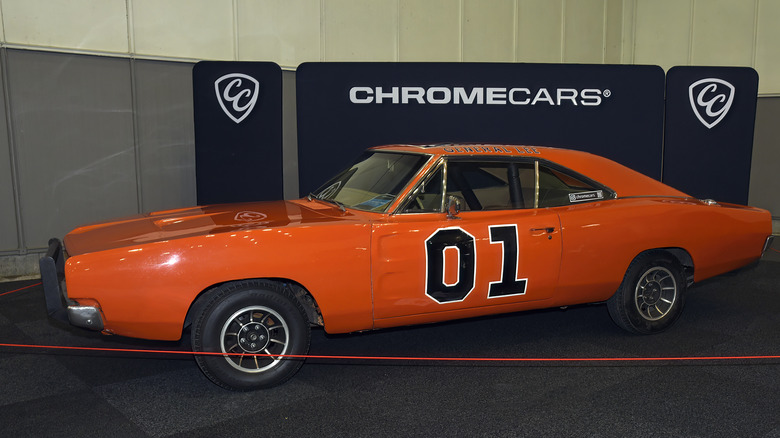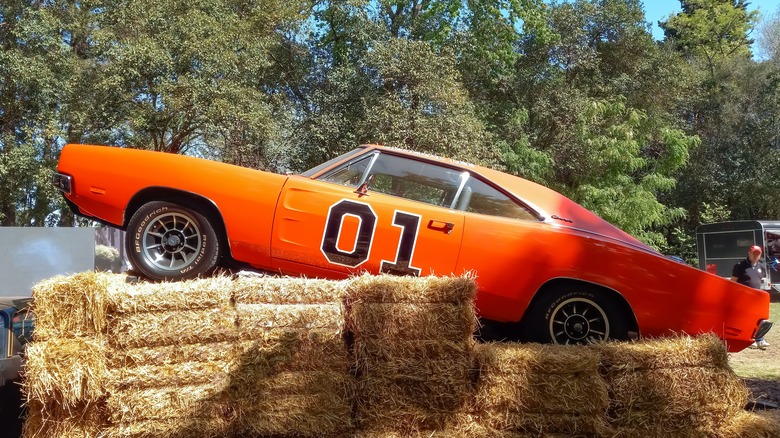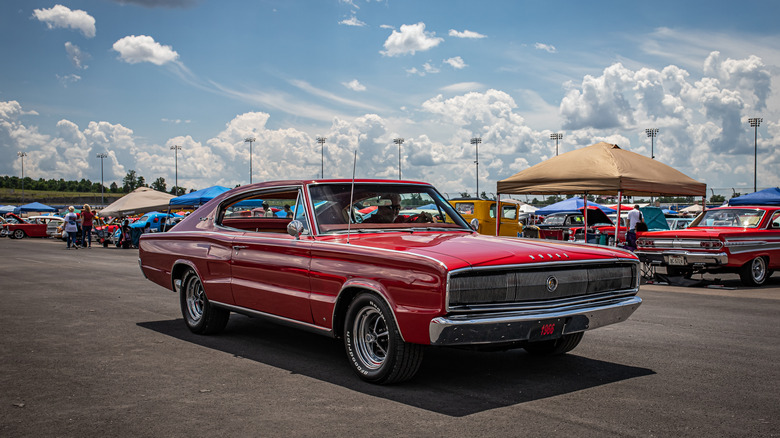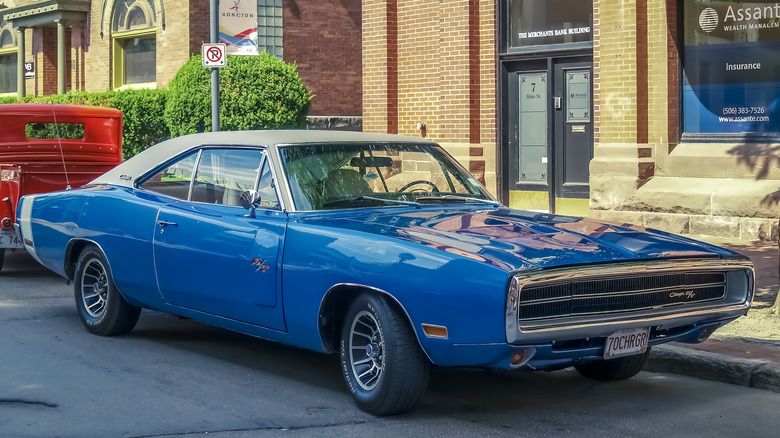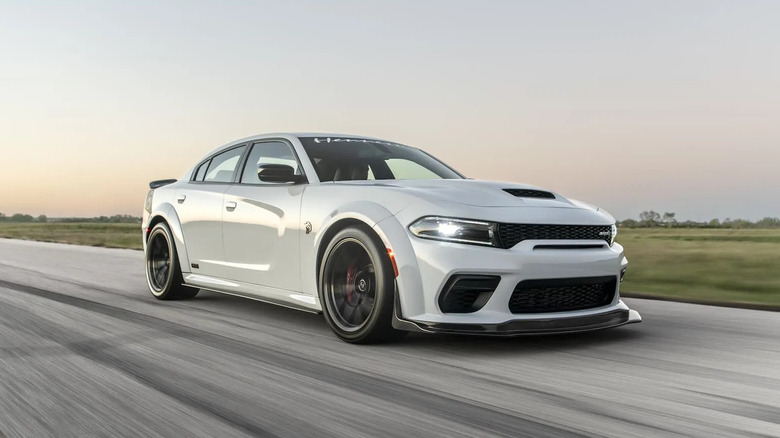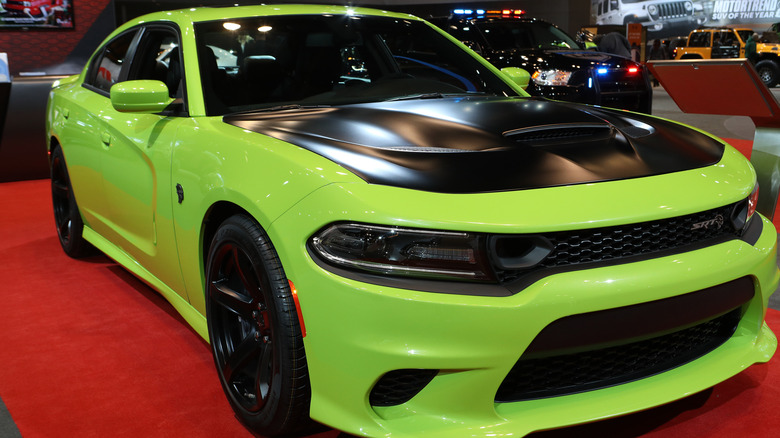5 Of The Best Dodge Charger Years Built With A HEMI Engine
With a muscle car, as any connoisseur will attest, the most important thing is just that: the muscle. They're vehicles built in the proudest of U.S. traditions: Unapologetically large and in charge, as subtle as a fluorescent, flaming chainsaw, the kinds of vehicles that left budding young gearheads awestruck. A muscle car doesn't have to be as gloriously large as the Imperial LeBaron to qualify as such, but it did have to have something truly formidable under the hood. For some such vehicles, that thing was a very specific and unique type of engine.
A hemispherical engine, or "Hemi" to its fans, has a combustion chamber of a half-spherical shape. The advantage of such a design is that it allows room for larger valves within the body of the engine, a bit of a space-saving design. This efficiency also means that the pressure within the chamber builds more quickly. Such two-valve engines were first created by Chrysler in 1951, with the initial model officially known as the FirePower engine — boasting 180 horsepower. Hemis would certainly go on to demonstrate their firepower for years as fixtures of some of the most acclaimed muscle cars ever. The legendary Dodge Charger is just one of them.
Here are some of the best Charger years that made use of the classic Hemi.
The 1969 Dodge Charger
1969 marked a continuation of the second generation of the Dodge Charger. You could say this was the generation that truly marked the Charger as an all-star legendary vehicle. You could also say that countless people saw this breed of Charger on the likes of "Dukes of Hazzard" and were tempted into buying one of them in order to indulge their fantasies of driving the General Lee for themselves.
The Dukes' model was a 1969 Charger, which made it rather more unique than the first generation of this classic. Here was a vehicle that dared to be different, to break further away from the shadow of the Coronet with its distinctive taillights and by dispensing with the fastback image that is most certainly not for everybody. The muscle of this newly made muscle car was supplied by a choice of different engines, one of which was the Street Hemi that was incorporated in some 1969 Charger 500s.
This particular model was created to allow the '69 Charger to compete in NASCAR — stock cars couldn't do so unless there was an equivalent roadworthy model available to the public — and almost 400 of the Charger 500 were made in order to adhere to this. Motor Trend reports that 32 of these were built with Street Hemis.
The original 1966 Dodge Charger
In 1964, Chrysler unleashed its 426 Hemi. It was a racing engine, as it decisively showed in late February that same year. At the Daytona 500, Richard Petty and Plymouth claimed the first, second, and third spots — Petty would also achieve a time of 154.334 mph in the process, a new track record — with fifth place going to a Dodge Polara driven by Jim Paschal.
The following day, The New York Times reported that the Hemi was "not new in engine construction, but the Chrysler engineers had made some refinements on the engines built originally in 1955 and came up with this one. All of the Plymouths and Dodges in the race today were equipped with it."
The Street Hemi arrived in 1966, meaning it was equipped in some models of the very first Charger (this being its first model year). Around 11,000 vehicles were built with the colloquially-named Elephant Engine installed over its original five years in use, and one of them was the original Charger. In September 2023, one '66 Hemi appeared on Hemmings Auctions.
Hemmings reported that its first (and reportedly only) owner, who had offered it for sale at the auction, declared that a Hemi-equipped version cost "almost a thousand dollars more," around $9,400 in 2023. The power offered by the Hemi meant, they went on, that "almost nobody could ever catch it ... on a straight road, after 60 miles per hour, the Hemi just took over."
The 1970 Dodge Charger
With the Hemi being highlighted as one of the premium and most powerful options of the era, it's perhaps not surprising that earlier Hemi-equipped Chargers commanded a considerable extra price. The 1966 $1,000 in addition that the '66 Hemi reportedly cost is testament to that. So, too, is the fact that there were limited numbers of Hemis created in some model years. Next, we'll take a look at the 1970 Dodge Charger.
This model year's Charger featured a default 5.2 L V8 engine, but trim options included the considerably larger and more formidable (at 7L) V8 Hemi. Powered by the latter, it had up to 490 pound-feet of torque and 425 horsepower, which was considerable power to command in 1970. Power, further, that only a few drivers would wield: Dodge Garage reports that just 112 1970 Chargers were built equipped with Hemi engines.
In the case of this model year, it cost just under $650 to upgrade from the as-standard engine to the Hemi, so it was for the individual driver to decide whether the leap from 375 brake horsepower to this was worthwhile. This model year, an alternative choice made its debut: Chrysler's 440 Six Pack, base for the Charger R/T trim, which would go on to prove itself more popular. Hemis, unique and powerful as they are, would continue to be a part of the Dodge Charger story for decades.
The 2023 Dodge Charger
One thing that makes the purchase of a new vehicle so complicated is that trim options can make a huge difference, and your preferences may only match up with a specific one. If you're in the market for a 2023 Dodge Charger with a HEMI engine, though, you'll be glad to hear that several trims were made available that feature a Hemi engine.
By the time of 2023's Charger SRT Redeye, Jailbreak options were offered to allow a buyer to tweak everything from the color of their seatbelts to the specific styling of the car's badge. Style is one thing, but for such a vehicle, it's the power that's the first consideration. Happily, horsepower has forged forward into all new territory by this point.
In fact, the Widebody Charger Hellcat Jailbreak and Hellcat Redeye Jailbreak, Hennessy reported in April 2023, is an H1000 that hit 948 pound-feet of torque and 1,000 horsepower. These models, of course, aren't the standard-issue 2023 Chargers — instead designed for absolute potential, and they certainly offer just that.
Dodge declares its 'standard' 2023 Dodge Charger SRT Redeye Jailbreak to be capable of 707 pound-feet torque and 807 horsepower, by this time equipped with the 6.2 liter HEMI High-Output SRT — supercharged, of course.
The 2019 Dodge Charger
In 2015, the venerable Charger went through quite an extensive regime of changes in order to demonstrate just how timeless the model family is. This model year was all about combining a sleeker aesthetic with modern features, from the body to the futuristic touch screen entertainment system. Four years later, 2019's Charger was making more subtle yet significant changes to its looks and performance across the trim selection.
The 2019 Charger SXT, the 'base' model, features a Pentastar V6 outputting 292 horsepower, on top of enhanced headlamps and other new features. For something rather more formidable, buyers also had the option of the Charger R/T, Scat Pack, or the SRT Hellcat, each of which received the HEMI treatment in 370 horsepower, 485 horsepower, and 707 horsepower flavors, respectively.
This model year, the Charger range's tweaks and refinements included Houndstooth styling and a darker instrumental panel, along with improved seats and Bilstein-boosted suspension (depending on the trim). Performance doesn't only mean raw power, though, and drivers could also benefit from the all-wheel drive capacity of the vehicle.
2024 marks the beginning of the end for the Hemi as drivers have known it, becoming impractical as carbon emission regulations become increasingly stringent. Though new electric options are being explored, there's no doubt that the Charger will remain a beloved institution among drivers from all over the world, and the Hemi that became rather synonymous with high-end Chargers is a big part of its legacy, too.
